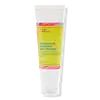What's inside
What's inside
 Key Ingredients
Key Ingredients

 Benefits
Benefits

 Concerns
Concerns

 Ingredients Side-by-side
Ingredients Side-by-side

Water
Skin ConditioningGlycerin
HumectantAspergillus Ferment
Skin ConditioningPropanediol
SolventCetearyl Alcohol
EmollientSaccharomyces Ferment
Skin ConditioningCetyl Tranexamate Mesylate
Skin ConditioningGlyceryl Stearate
EmollientNiacinamide
SmoothingBehentrimonium Methosulfate
Simmondsia Chinensis Seed Oil
EmollientPanthenol
Skin ConditioningPalmitic Acid
EmollientCaprylyl Glyceryl Ether
CleansingCapryloyl Salicylic Acid
ExfoliatingStearic Acid
CleansingArginine
MaskingCaprylhydroxamic Acid
Sodium Hydroxide
BufferingWater, Glycerin, Aspergillus Ferment, Propanediol, Cetearyl Alcohol, Saccharomyces Ferment, Cetyl Tranexamate Mesylate, Glyceryl Stearate, Niacinamide, Behentrimonium Methosulfate, Simmondsia Chinensis Seed Oil, Panthenol, Palmitic Acid, Caprylyl Glyceryl Ether, Capryloyl Salicylic Acid, Stearic Acid, Arginine, Caprylhydroxamic Acid, Sodium Hydroxide
Water
Skin ConditioningEthylhexyl Methoxycinnamate
UV AbsorberDiethylamino Hydroxybenzoyl Hexyl Benzoate
UV FilterCetyl Alcohol
EmollientGlyceryl Stearate
EmollientCeteareth-20
CleansingCeteareth-12
EmulsifyingCetearyl Alcohol
EmollientCetyl Palmitate
EmollientDimethicone
EmollientLactobacillus Ferment
Skin ConditioningAvena Sativa Kernel Extract
AbrasiveSodium Benzoate
MaskingPotassium Sorbate
PreservativeC12-15 Alkyl Benzoate
AntimicrobialUndecylenoyl Phenylalanine
Skin ConditioningMethylene Bis-Benzotriazolyl Tetramethylbutylphenol
UV FilterDecyl Glucoside
CleansingPropylene Glycol
HumectantXanthan Gum
EmulsifyingButyrospermum Parkii Butter
Skin ConditioningEthylhexyl Triazone
UV AbsorberOctocrylene
UV AbsorberSaccharide Isomerate
HumectantCitric Acid
BufferingSodium Citrate
BufferingParfum
MaskingNiacinamide
SmoothingPentaerythrityl Distearate
EmulsifyingPhenoxyethanol
PreservativeEthylhexylglycerin
Skin ConditioningCaprylyl Glycol
EmollientPolyacrylate Crosspolymer-11
Emulsion StabilisingKojic Acid
AntioxidantTocopheryl Acetate
AntioxidantCollagen
MoisturisingDipotassium Glycyrrhizate
HumectantEDTA
Water, Ethylhexyl Methoxycinnamate, Diethylamino Hydroxybenzoyl Hexyl Benzoate, Cetyl Alcohol, Glyceryl Stearate, Ceteareth-20, Ceteareth-12, Cetearyl Alcohol, Cetyl Palmitate, Dimethicone, Lactobacillus Ferment, Avena Sativa Kernel Extract, Sodium Benzoate, Potassium Sorbate, C12-15 Alkyl Benzoate, Undecylenoyl Phenylalanine, Methylene Bis-Benzotriazolyl Tetramethylbutylphenol, Decyl Glucoside, Propylene Glycol, Xanthan Gum, Butyrospermum Parkii Butter, Ethylhexyl Triazone, Octocrylene, Saccharide Isomerate, Citric Acid, Sodium Citrate, Parfum, Niacinamide, Pentaerythrityl Distearate, Phenoxyethanol, Ethylhexylglycerin, Caprylyl Glycol, Polyacrylate Crosspolymer-11, Kojic Acid, Tocopheryl Acetate, Collagen, Dipotassium Glycyrrhizate, EDTA
 Reviews
Reviews

Ingredients Explained
These ingredients are found in both products.
Ingredients higher up in an ingredient list are typically present in a larger amount.
Cetearyl alcohol is a mixture of two fatty alcohols: cetyl alcohol and stearyl alcohol. It is mainly used as an emulsifier. Emulsifiers help prevent the separation of oils and products. Due to its composition, it can also be used to thicken a product or help create foam.
Cetearyl alcohol is an emollient. Emollients help soothe and hydrate the skin by trapping moisture.
Studies show Cetearyl alcohol is non-toxic and non-irritating. The FDA allows products labeled "alcohol-free" to have fatty alcohols.
This ingredient is usually derived from plant oils such as palm, vegetable, or coconut oils. There is debate on whether this ingredient will cause acne.
Due to the fatty acid base, this ingredient may not be Malassezia folliculitis safe.
Learn more about Cetearyl AlcoholGlyceryl Stearate is a mix of glycerin and stearic acid.
It is used to stabilize the mixing of water and oil ingredients. By preventing these ingredients from separating, it can help elongate shelf life. It can also help thicken the product's texture.
As an emollient, it helps soften skin and supports barrier-replenishing ingredients.
In cosmetics, Glyceryl Stearate is often made from vegetable oils or synthetically produced.
This ingredient may not be fungal-acne safe
Fun fact: The human body also creates Glyceryl Stearate naturally.
Learn more about Glyceryl StearateNiacinamide is a multitasking form of vitamin B3 that strengthens the skin barrier, reduces pores and dark spots, regulates oil, and improves signs of aging.
And the best part? It's gentle and well-tolerated by most skin types, including sensitive and reactive skin.
You might have heard of "niacin flush", or the reddening of skin that causes itchiness. Niacinamide has not been found to cause this.
In very rare cases, some individuals may not be able to tolerate niacinamide at all or experience an allergic reaction to it.
If you are experiencing flaking, irritation, and dryness with this ingredient, be sure to double check all your products as this ingredient can be found in all categories of skincare.
When incorporating niacinamide into your routine, look out for concentration amounts. Typically, 5% niacinamide provides benefits such as fading dark spots. However, if you have sensitive skin, it is better to begin with a smaller concentration.
When you apply niacinamide to your skin, your body converts it into nicotinamide adenine dinucleotide (NAD). NAD is an essential coenzyme that is already found in your cells as "fuel" and powers countless biological processes.
In your skin, NAD helps repair cell damage, produce new healthy cells, support collagen production, strengthen the skin barrier, and fight environmental stressors (like UV and pollution).
Our natural NAD levels start to decline with age, leading to slower skin repair, visible aging, and a weaker skin barrier. By providing your skin niacinamide, you're recharging your skin's NAD levels. This leads to stronger, healthier, and younger looking skin.
Another name for vitamin B3 is nicotinamide. This vitamin is water-soluble and our bodies don't store it. We obtain Vitamin B3 from either food or skincare. Meat, fish, wheat, yeast, and leafy greens contain vitamin B3.
The type of niacinamide used in skincare is synthetically created.
Learn more about NiacinamideWater. It's the most common cosmetic ingredient of all. You'll usually see it at the top of ingredient lists, meaning that it makes up the largest part of the product.
So why is it so popular? Water most often acts as a solvent - this means that it helps dissolve other ingredients into the formulation.
You'll also recognize water as that liquid we all need to stay alive. If you see this, drink a glass of water. Stay hydrated!
Learn more about Water